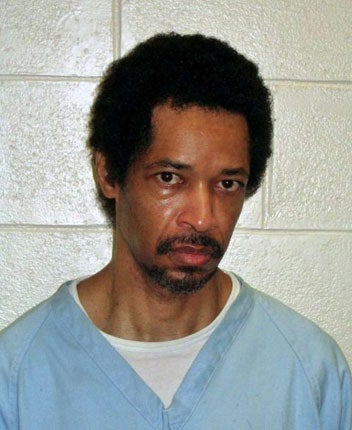Washington sniper John Allen Muhammad executed

Your support helps us to tell the story
From reproductive rights to climate change to Big Tech, The Independent is on the ground when the story is developing. Whether it's investigating the financials of Elon Musk's pro-Trump PAC or producing our latest documentary, 'The A Word', which shines a light on the American women fighting for reproductive rights, we know how important it is to parse out the facts from the messaging.
At such a critical moment in US history, we need reporters on the ground. Your donation allows us to keep sending journalists to speak to both sides of the story.
The Independent is trusted by Americans across the entire political spectrum. And unlike many other quality news outlets, we choose not to lock Americans out of our reporting and analysis with paywalls. We believe quality journalism should be available to everyone, paid for by those who can afford it.
Your support makes all the difference.John Allen Muhammad, the mastermind behind the sniper attacks that left 10 dead, was executed as relatives of the victims watched, reliving the killing spree that terrorized the Washington DC area for three weeks in October 2002.
The 48-year-old Muhammad looked calm and stoic, but was twitching and blinking, tapping his left foot as the injections began, defiant to the end, refusing to utter any final words. Victims' families sat behind glass while watching, separated from the rest of the 27 witnesses, who were quiet, looking straight forward, intent on what was happening.
"He died very peacefully, much more than most of his victims," said Prince William County prosecutor Paul Ebert, who witnessed Muhammad die by injection at 9:11 p.m. Tuesday at Greensville Correctional Center, south of Richmond.
Muhammad was executed for killing Dean Harold Meyers, who was shot in the head at a Manassas gas station during the three-week spree across Maryland, Virginia and Washington, D.C.
The shootings terrorized the Washington region, as victim after victim was shot down while doing everyday chores: shopping, pumping gas, mowing the lawn. One child was shot while walking into his middle school.
People stayed indoors. Those who had to go outside weaved as they walked or bobbed their heads to make themselves a less easy target.
The terror ended on 24 October 2002, when police captured Muhammad and his teenage accomplice, Lee Boyd Malvo, while they slept at a Maryland rest stop in a car they had outfitted for a shooter to perch in its trunk without being detected.
Malvo, who was 17 when carrying out the attacks, was sentenced to life in prison without parole for killing Linda Franklin, a 47-year-old FBI analyst who was shot as she and her husband loaded supplies at a Home Depot in Falls Church, Virginia.
The men also were suspected of fatal shootings in other states, including Louisiana, Alabama and Arizona.
Nelson Rivera, whose wife, Lori Ann Lewis-Rivera, was gunned down as she vacuumed her van at a Maryland gas station, said that when he watched Muhammad's chest moving for the last time, he was glad.
"I feel better. I think I can breathe better and I'm happy he's gone because he's not going to hurt anyone else," he said.
Muhammad never testified or explained why he directed the shootings, and his secrets died with him.
Meyers' brother, Bob Meyers, said watching the execution was sobering and "surreal."
"I would have liked him at some point in the process to take responsibility, to show remorse," Meyers said. "We didn't get any of that tonight."
J. Wyndal Gordon, one of Muhammad's attorneys, described his client in his final hours as fearless and still insisting he was innocent.
"He will die with dignity — dignity to the point of defiance," Gordon said.
The U.S. Supreme Court turned down Muhammad's final appeal Monday, and Virginia Gov. Timothy M. Kaine denied clemency Tuesday.
Muhammad's attorneys had asked Kaine to commute his sentence to life in prison because they said Muhammad had brain damage and neurological problems, as well as psychotic and delusional behavior, exacerbated by the Gulf War Syndrome he suffered as a sergeant in the first Iraq war.
"I think crimes that are this horrible, you just can't understand them, you can't explain them," said Kaine, a Democrat known for carefully considering death penalty cases. "They completely dwarf your ability to look into the life of a person who would do something like this and understand why."
A small group of death penalty opponents gathered on a grassy area near the prison and had a sign reading, "We remember the victims, but not with more killing."
Muhammad was born John Allen Williams and changed his name after converting to Islam. He had been in and out of the military since he graduated from high school in Louisiana and entered the National Guard. He joined the Army in 1985. He did not take special sniper training but earned an expert rating in the M-16 rifle — the military cousin of the .223-caliber Bushmaster rifle used in the D.C. shootings.
The motive for the attacks remains murky. Malvo said Muhammad wanted to extort $10 million from the government to set up a camp in Canada where homeless children would be trained as terrorists. Muhammad's ex-wife said she believes the killings were a smoke screen for his plan to kill her and regain custody of their three children.
Sonia Hollingsworth-Wills, the mother of Conrad Johnson, the last man slain that October, sat in the back seat of a car outside the prison before the execution, which she chose not to witness. But she said she wanted to be there and was counting the minutes until Muhammad's death.
"It was the most horrifying day of my life," she said. "I'll never get complete closure but at least I can put this behind me."
Join our commenting forum
Join thought-provoking conversations, follow other Independent readers and see their replies
Comments